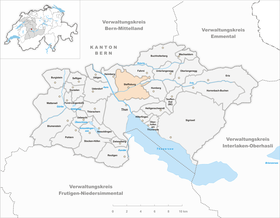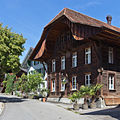Steffisburg
| Steffisburg | |
|---|---|
| State : |
|
| Canton : |
|
| Administrative district : | Tuna |
| BFS no. : | 0939 |
| Postal code : | 3612, 3613 |
| UN / LOCODE : | CH SBG |
| Coordinates : | 614 868 / 181370 |
| Height : | 585 m above sea level M. |
| Height range : | 546-1034 m above sea level M. |
| Area : | 14.81 km² |
| Residents: | 15,959 (December 31, 2018) |
| Population density : | 1078 inhabitants per km² |
|
Proportion of foreigners : (residents without citizenship ) |
9.5% (2,009) |
| Unemployment rate : | 2.4% (2,010) |
| Mayor : | Jürg Marti ( SVP ) |
| Website: | www.steffisburg.ch |
|
Aerial view of Steffisburg |
|
| Location of the municipality | |
Steffisburg is a municipality in the Thun administrative district in the canton of Bern in Switzerland . The name Steffisburg is formed from the saint's name Stephan and the Old High German generic word Burg. Although the place has grown to an urban size with 15,800 inhabitants in the last few decades, Steffisburg still describes itself as a “village”.
geography
Steffisburg is located in a pre-alpine hilly landscape on the Zulg , on the edge of the Bernese Oberland . Steffisburg is a suburb north of Thun. The neighboring communities of Steffisburg are Thun , Homberg , Fahrni , Unterlangenegg , Uetendorf and Heimberg . The center is at an altitude of 585 m. ü. M., the highest point at 890 m. ü. M.
Somewhat separate from the village, directly in front of the former city gates of Thun, are the Schwäbis and Sonnenfeld districts. In addition to large residential buildings, schools and churches, a dairy, sawmill and part of the Thun arsenal have settled here.
Coat of arms and castle
The location of the castle depicted on the coat of arms is unclear today. On the one hand, it could have stood at the current location of the church, the small Nagelfluhrippe above the upper village. According to these assumptions, the name “castle” would have been preceded by the name of the patron saint of the church, Stephen. Archaeological finds in 2007 make the "Grosse Höchhus" seem plausible as another possible location for the castle.
history
The prehistory is in the dark because very few finds indicate an early settlement.
Gallic-Roman period
Helvetic origin is probably the river name Zulg (formerly Zull, Zulle, Zulla ), the Gallic Tullo '(see., (Arrival) altitude air. Tullow , hill', walis. Twlch , bump, bump '). Golaten, the name of a small ravine in the Bösbach, clearly reflects the Gallo-Roman golatta ' small ravine '. Remnants of a Roman estate were found during the construction of the dairy association in Schwäbis.
Migration period
Undoubted evidence of settlement in the early Middle Ages are several archaeological finds and the Alemannic field names Ortbühl, Tüchtiwil, Hardegg, Hartlisberg, Siglisberg u. a.
Late Middle Ages and Modern Times
The place name Stevansburc first appeared in a document in 1133. Until 1218, Berchtold V. von Zähringen, the founder of Bern, administered the area. His heirs were the Kyburger. The Romanesque tower of the village church dates from the 12th century and is today the oldest architectural monument in the community.
The “Free Court on the Louwinen” with today's communities of Steffisburg, Heimberg, Brenzikofen, Herbligen, Fahrni, Unter- and Oberlangenegg, Eriz, Horrenbach-Buchen, Homberg, Teuffenthal, Schwendibach, Goldiwil, Heiligenschwendi and Sigriswil came to Bern in 1385. In 1405, the "Frygricht Landrächt" recorded ancient freedoms and rights in writing and regulated the administration of the free court. The land letter was renewed both in 1471 and 1535, and in 1471 the free courts of Steffisburg and Sigriswil were separated.
The two great landlords of Steffisburg, the Interlaken monastery and Heinrich Matter , transferred the rights to the village community to watch over the Allmend and the forest in 1449 (Heinrich Matter owned the Höchhus, some mills, many large farms, vineyards and several houses in the village ).
The Steffisburger, previously governor Peter Surer, bought Matter's goods with the rights of rule in 1539. During Surer's tenure, the "Landhaus" was built as a court house in the Steffisburg countryside, which was used as the "Landhaus" inn until February 2012.
The irritable mood of the Steffisburgers against the arrogant authorities was evident in the Peasants' War in 1653, in which captain and governor Hans Berger played an important role. He escaped execution by fleeing abroad.
A powder mill was operated from 1586 to 1864 until the Swiss Confederation closed and the ammunition factory was opened in Thun.
In 1798 the French marched into Steffisburg. Governor Kaspar Schweizer resolutely resisted their exaggerated demands. During the Helvetic Republic he was the first district manager of the landscape for a short time.
In 1825, the village assembly decided to separate the civil and resident communities. The orphans, poor, streets, threshold and police affairs were transferred to the community. After the new constitution came into force in 1831, the “Frygricht Landrächt” was finally replaced by cantonal laws. The so-called separation agreement between the residents' community and the civic community was concluded in 1861.
In 1947, due to a new community organization, the ballot box and the large community council (with the now full-time community president at the top) took the place of the community assembly.
politics
The municipal council forms the executive power of the Steffisburg municipality. In the 2019-2020 legislature it is made up as follows: 2 SVP , 2 SP , 1 FDP , 1 EDU and 1 green liberal . The community president is Jürg Marti ( SVP ) , who is a member of the community council .
The large municipal council forms the legislature . It consists of 34 members and is elected for four years by those entitled to vote. The graphic on the right shows the current distribution of seats in the Great Municipal Council (result of the 2018 municipal elections).
The voting shares of the parties in the 2019 National Council elections were: SVP 30.1%, SP 13.0%, GPS 11.4%, glp 10.0%, EPP 8.9%, FDP 8.6%, BDP 7.2 %, EDU (incl. DM) 5.4%, CVP 1.1%.
economy
There are around 4,000 jobs in the community. The largest employer in the community is Fritz Studer AG (600 employees), a manufacturer of precision cylindrical grinding machines.
traffic
Steffisburg is connected to the public transport network by the STI bus routes 1 and 3 in the direction of Thun. From 1913 to 1958 the place was served by the Steffisburg – Thun – Interlaken tram. Steffisburg is touched on the western edge of the Thun – Burgdorf railway line , but due to their peripheral location, the Steffisburg and Schwäbis stations are not of great importance for the development of the community.
Culture
The city has its own art collection. The Steffisburg Art Commission organizes two art exhibitions annually in the Villa Schüpbach on behalf of the local council . In recent years several exhibitions have taken place, for example about Jakob Jenzer , Henriette Sechehaye , Otto Nebel or Stefan Haenni .
The pictures from the Hans & Marlis Suter art collection are regularly shown in exhibitions in the Höchhus , for example works by Paul Freiburghaus , Bendicht Friedli , Knud Jacobsen , Helene Pflugshaupt , Victor Surbek or Fred Stauffer .
Attractions
- The village church in the upper village
- Big Höchhus
Town twinning
-
 Jindřichův Hradec , Czech Republic. This town twinning, which existed from 1992 to the end of 2008, was terminated by the municipality of Steffisburg.
Jindřichův Hradec , Czech Republic. This town twinning, which existed from 1992 to the end of 2008, was terminated by the municipality of Steffisburg.
Personalities
- Ana Maria Crnogorčević (* 1990), Swiss football player
- Barbara Egger-Jenzer (* 1956), politician, member of the government of the Canton of Bern
- Anton Gäumann (* 1960), Swiss manager
- Robert Schär (1894–1973), Swiss glass painter and painter
- Arthur Loosli (* 1926), concert singer and painter
- Roman Tschabold (1900–1990), Swiss graphic artist, painter, ceramist, sculptor and architect.
- David Tschanz (1717–1784), founder of the pietistic movement Heimberger Brothers
Honorary citizen of Steffisburg
- Hans Bietenhard (1916–2008), Protestant Reformed pastor, New Testament scholar and Bible translator
- Ruth Bietenhard (1920–2015), journalist, teacher and Bible translator
Web links
- Official website of the municipality of Steffisburg
- Anne-Marie Dubler : Steffisburg. In: Historical Lexicon of Switzerland .
- interactive panorama of the community of Steffisburg
Individual evidence
- ↑ Permanent resident population from STAT-TAB of the BfS , municipalities see also regional portraits 2020 on bfs.admin.ch, accessed on May 29, 2020
- ^ Community search . Population. (No longer available online.) In: Official website. Federal Statistical Office, 2011, p. 1 , archived from the original on July 30, 2012 ; accessed on August 28, 2011 (input from Steffisburg ). Info: The archive link was inserted automatically and has not yet been checked. Please check the original and archive link according to the instructions and then remove this notice.
- ^ Community search . Job. (No longer available online.) In: Official website. Federal Statistical Office, 2011, p. 1 , archived from the original on July 30, 2012 ; accessed on August 28, 2011 (input from Steffisburg . Annual average). Info: The archive link was inserted automatically and has not yet been checked. Please check the original and archive link according to the instructions and then remove this notice.
- ^ Press release from the Canton of Bern on archaeological finds
- ↑ https://www.steffisburg.ch/de/politik-verwaltung/politik/wahlen/Archiv-Wahlen/2018-25-11/GR_Formular-5b.pdf
- ↑ steffisburg.ch
- ↑ Elections and Votes. Retrieved November 24, 2019 .
- ^ Hans Peter Würsten: Steffisburg village church BE. (Swiss Art Guide, No. 443). Ed. Society for Swiss Art History GSK. Bern 1989, ISBN 3-85782-443-3 .
- ↑ Armand Baeriswyl, Irene Bruneau: Steffisburg, Grosse Höchhus. (Swiss Art Guide, Series 98, No. 976). Edited by the Society for Swiss Art History GSK., Bern 2015, ISBN 978-3-03797-230-4 .
- ↑ Administrative report 2008 of the Steffisburg municipal council. (PDF) Point 1.4 Partnership with the Czech Republic: Cancellation of the partnership at the end of 2008. (No longer available online.) Municipality of Steffisburg, 2009, p. 27 , archived from the original on October 25, 2014 ; Retrieved October 25, 2014 . Info: The archive link was inserted automatically and has not yet been checked. Please check the original and archive link according to the instructions and then remove this notice.
















